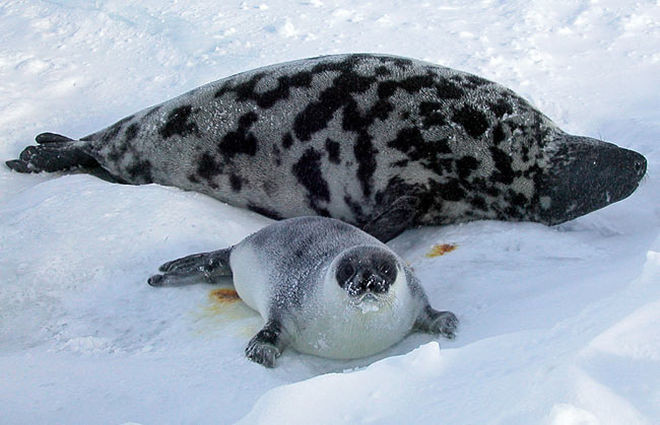The link between human milk and wild animal milk
Overall, 700 million tons of milk is produced worldwide every year. But this statistic of course misses the milk of a mammal, that is human.
According to the BBC, in mammals, females produce milk to feed their young. The composition of milk depends on many factors, from environmental temperature to lactation.
According to a breastfeeding study by the US Centers for Disease Control and Prevention (CDC), human milk has many similarities with the milk of an African wildlife.
In the world, there are 9 cups of fresh milk, 9 cups are made from animal milk. The other cup comes from goats, buffaloes, sheep and camels. Although less common, human beings also use milk from domestic or semi-wild animals such as llamas, elk, musk and yaks.

Seal milk contains 61% fat, the most energetic milk in nature.(Photo: ITsnature).
All mammals are capable of producing milk, from animals that lay eggs like platypuses to marsupials such as kangaroo and common species like rabbits, tigers, dolphins and monkeys.
Due to different nutritional needs and habitats, each female will produce different amounts of milk and nutrient ratio.
For example, seals live in cold North Atlantic coastal areas. The body of a baby needs to form a thick layer of fat to cope with harsh living conditions, so that it can swim and search for it under ice-cold water. Therefore, their milk contains 61% fat, only 5% protein and 1% sugar.
Mother seals often give birth to babies on ice sheets and they only have a few days to take care of them on the ice to avoid being hunted by white bears. During this time, the mother seal transmits up to 6kg of fat-rich milk every day to help her quickly adapt to the environment.
In herbivores, mother animals often feed their babies for weeks, months. They do not have to convert energy quickly to children in a short time like seals. Therefore, they breastfeed according to the needs of the offspring. Milk of rhino usually contains 0.2% fat. This ratio in mother gorilla milk is 1.5%.
Human milk lies between these two types of milk. Newborn babies need to be cared for for a long time. This also allows mothers to produce a diluted milk and contain more water. In breast milk, up to 90% is water. Because if breastmilk is as rich as seal milk, the mother will not have the energy to take care of her child. The fact is that human milk contains 4% fat, 1.3% protein, and 7.2% lactose (milk sugar).
Two Katie Hinde anthropologists and Lauren Milligan said that mother zebra milk is quite similar to human milk, with 2.2% fat, 1.6% protein, 7% lactose, and 89% water. Human milk and zebra are both rich in water and low in energy. And energy in milk comes primarily from lactose, not from fat.

Breast milk includes nutrition and antibodies to prevent many infectious diseases.(Photo: Express).
Through evolution, the animals' milk has also changed so that the offspring adapt to the environment. To fully understand the evolution of breast milk, biologist Amy L Skibiel from Auburn University, USA, studied the milk components of 130 different mammal species.
She discovered that animals are closely related, their milk is quite similar . From the perspective of genetics, the duration of breastfeeding is the predictor of milk composition. Seals feed breastmilk for about four days, so their milk is high in energy, while bottlenose dolphins feed their babies for 18 months.
The next factor that determines milk composition is the diet of each species . Mammals eat meat like tigers are high in fat and protein than herbivores like giraffes and antelopes.
In one theory, milk works to promote the development of the immune system of young offspring. Antibodies transmitted from the mother help the baby's body form a protective layer against infectious diseases. Another theory is that the original milk acts as a moisturizer for the skin. The newly hatched platypus also breastfeeds, but instead of sucking from the nipple, they lick the milk secreted from the sweat glands on the mother's body.

Synapsid, which existed 160 million years ago, is the first breast-feeding animal in history.(Photo: Wikipedia).
In the end, human milk or animal milk is the result of millions of years of evolution from the first egg-laying mammal called a synapsid or an animal's side . Surviving 160 million years ago, this animal was described as an animal-like reptile.
Thanks to this evolution, today we enjoy all the benefits of milk including nutrition, antibodies, moisture . as well as dairy products like butter, yogurt, cheese.
- 10,000 years of human experience drinking cow's milk
- Things to know about nut milk and health
- Fresh milk is not completely safe
- Should choose milk according to nutritional needs
- Transgenic dairy cows produce human milk
- Cow 'for human milk'
- Goat secretes human milk
- Discover the tribe raising animals with human milk
- This is the most important animal for Tibetans
- Goats for milk like human milk
- Genetically modified cows make milk safer
- Do children necessarily have to drink milk?
 'Fine laughs' - Scary and painful torture in ancient times
'Fine laughs' - Scary and painful torture in ancient times The sequence of numbers 142857 of the Egyptian pyramids is known as the strangest number in the world - Why?
The sequence of numbers 142857 of the Egyptian pyramids is known as the strangest number in the world - Why? History of the iron
History of the iron What is alum?
What is alum?